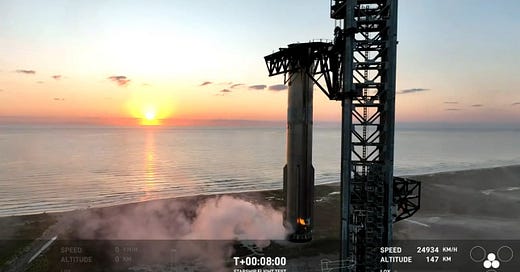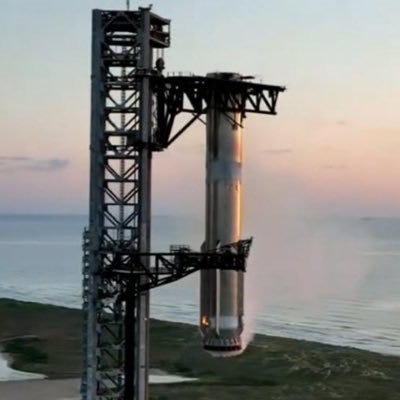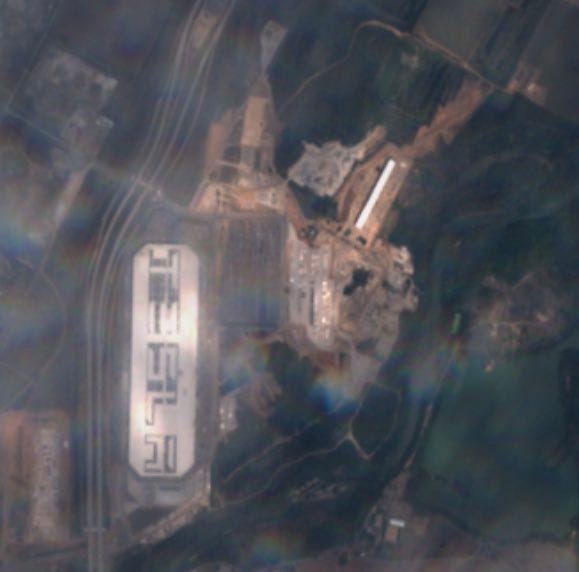'Per aspera ad astra'— Elon Musk: "Big step towards making life multiplanetary was made today.”
SpaceX's Historic October 13 Starship Launch Marks a New Era in Space Exploration.
Unprecedented Starship Launch Success
SpaceX has redefined the limits of space exploration with the triumphant launch and landing of its colossal Starship rocket on October 13, 2024. Lifting off from the southern tip of Texas, this historic event marks a watershed moment for Elon Musk’s visionary space enterprise. Towering at 400 feet (121 meters), Starship is not only the largest but also the most powerful rocket ever built, positioning SpaceX to embark on even more groundbreaking missions1. Celebrating the achievement, Elon Musk captured the significance of the moment in a tweet: “Big step towards making life multiplanetary was made today.”
This particular test flight wasn’t just another demonstration of technological prowess but a major leap towards sustainable space exploration. SpaceX achieved multiple milestones in a single flight, further solidifying its position at the forefront of the aerospace industry.
Groundbreaking Achievements of the Launch
Successful Booster Catch by 'Chopsticks' Arms
One of the most remarkable achievements of this mission was the successful capture of the Super Heavy booster by SpaceX’s innovative mechanical arms, known as "chopsticks." In previous launches, the boosters typically ended their journey in the Gulf of Mexico. However, for the first time, the booster was skillfully caught by these mechanical arms as it returned to the launch pad. This milestone underscores SpaceX’s unwavering commitment to rapid reusability and cutting costs in space travel. In an official tweet (see video), SpaceX highlighted the broader significance of this innovation: “The 1-million square foot Starfactory brings many parts of the manufacturing process under one roof for the first time, moving as much system integration work as possible earlier in the build process, with the goal of eventually producing 1,000 Ships a year.”
Improved Performance Based on Prior Test Flights
Building on lessons from earlier missions, including the partial success of the June 2024 flight, SpaceX has made significant enhancements to Starship’s design. Improvements to the heat shield and software upgrades ensured a smoother and more efficient mission. This fifth test flight demonstrated that SpaceX is steadily mastering the intricacies of Starship’s enormous power and capabilities (22 sec landing video).
Full Mission Profile Success
This test marked the first time that SpaceX aimed to execute a full mission profile. From a successful booster separation to Starship’s planned splashdown in the Indian Ocean, the mission met all key objectives. This comprehensive approach lays the groundwork for SpaceX’s future lunar and interplanetary ambitions.
Unmatched Power in the Launch Vehicle
Starship is powered by 33 Raptor engines, which together provide unparalleled thrust, making it the most powerful launch vehicle ever developed. The ability to safely land and recover such a large vehicle shows that SpaceX is one step closer to achieving its long-term goal of reusing rockets to reduce the cost of space travel and boost mission frequency.
Future Space Exploration and NASA Collaboration
This successful test flight (hour long video to takeoff) signals the dawn of a new era for SpaceX and the future of space travel. NASA has already placed orders for two Starships to be used in future lunar missions as part of its Artemis programme. Starship is also seen as a vital component for Elon Musk's vision of transporting people and cargo not only to the Moon but also to Mars and beyond.
The ability to catch and reuse boosters could revolutionise space travel by dramatically reducing costs. This innovative approach, along with the consistent improvements in Starship’s design and performance, reflects SpaceX’s long-term objective of making space exploration accessible and sustainable.
Why Elon Musk Prefers Texas for SpaceX Operations
Elon Musk’s preference for Texas as the base for SpaceX operations is rooted in a combination of regulatory flexibility and strategic advantage. Recent developments in California are merely illustrative of the challenges SpaceX faces in operating within the state's stringent environmental and regulatory framework. On October 11, 2024, the California Coastal Commission voted (6-4) to deny SpaceX’s request to increase rocket launches from Vandenberg Space Force Base, citing environmental concerns such as the impact of sonic booms on local wildlife and residents, as well as the need for more thorough environmental monitoring. The commission’s decision also accentuated the requirement for SpaceX to apply for a coastal development permit under state law, rejecting the notion that these launches fall solely under federal jurisdiction.
Texas: A Strategic Hub for Musk’s Ambitions
Elon Musk’s decision to base major operations in Texas is part of a broader strategy to bypass the bureaucratic hurdles that often slow progress in California. This approach was not only evident in SpaceX’s operations but also in the location of Tesla’s Gigafactory in Austin. Musk famously chose Austin over California due to the latter’s cumbersome regulatory processes. At the inauguration of the Austin Gigafactory, Musk remarked, "In the time we built the factory here, the California bureaucrats would still have been busy studying our factory plans." In July, he announced that X (formerly twitter) HQ will also move to Austin.
Texas, in contrast, provides a more business-friendly environment that aligns with Musk’s ambitious timelines for innovation. The southern tip of Texas, where SpaceX’s Starbase is located, offers fewer regulatory restrictions and a more flexible permitting process compared to California’s stringent environmental laws. The state’s open spaces and proximity to the ocean make it an ideal location for large-scale rocket launches and testing. Free from the political and regulatory controversies that have stalled expansion efforts in California, Texas— a staunchly Republican state— enables SpaceX to pursue rapid reusability and frequent launches, vital to Musk’s vision of making life multiplanetary.
A Bright Future for SpaceX and Human Space Exploration
The October 13 Starship launch marks more than just a successful test flight—it represents a giant leap towards the future of space exploration. By mastering rapid reusability and pushing the envelope in rocket power and design, SpaceX is setting the stage for more frequent, cost-effective, and ambitious missions.
This achievement not only strengthens SpaceX’s place as a leader in the aerospace sector but also brings humanity one step closer to reaching new frontiers (short video). As the boundaries of space exploration expand, so too does the promise of what humankind can achieve in the cosmos, with SpaceX at the helm of this bold journey into the stars. Driven by the underlying ambition of making life not only multiplanetary but also interplanetary, SpaceX embodies the spirit of "Per aspera ad astra"—through hardships to the stars.
Qutub Minar: 240 feet






